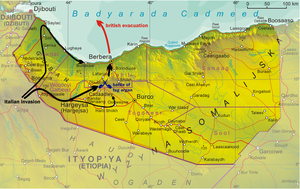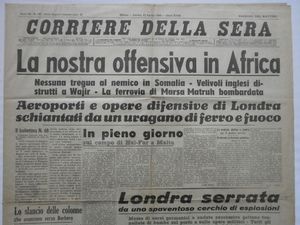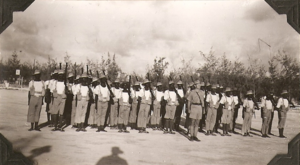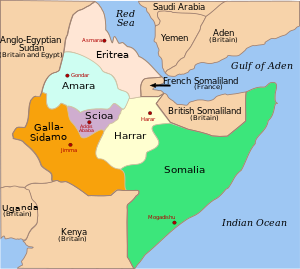الغزو الإيطالي للصومال البريطاني
| Italian conquest of British Somaliland | |||||||||
|---|---|---|---|---|---|---|---|---|---|
| جزء من حملة شرق أفريقيا في الحرب العالمية الثانية | |||||||||
 الفتح الإيطالي لأرض الصومال البريطاني، أغسطس 1940 | |||||||||
| |||||||||
| المتحاربون | |||||||||
| |||||||||
| القادة والزعماء | |||||||||
|
Reade Godwin-Austen Arthur Chater |
Guglielmo Nasi كارلو دى سيمونى | ||||||||
| القوى | |||||||||
| 5,000 regular troops[أ] | 24,000 قوات استعمارية[2] | ||||||||
| الضحايا والخسائر | |||||||||
|
50 killed 105 wounded[1] 120 missing[ب] 7 aircraft destroyed 10 aircraft damaged[4][3] 1 tug lost 2 vessels slightly damaged[5] |
465 killed[3][6] 1,530 wounded[3][6] 4 aircraft destroyed[6] | ||||||||
|
Up to 2,000 Somalis killed or wounded fighting in the Bande irregolari against British rule.[ت] Around 1,000 Somali irregulars killed or wounded fighting against the Italian invasion.[8] | |||||||||
الفتح الإيطالي لأرض الصومال البريطاني كان حملة عسكرية في شرق أفريقيا، حدث في أغسطس 1940 بين قوات إيطاليا وقوات بريطانيا وعدد من مستعمراتها وبلدان الكومنولث. التجريدة الإيطالية كانت جزءاً من حملة شرق أفريقيا في الحرب العالمية الثانية.
خلفية
شرق أفريقيا الإيطالي
On 9 May 1936, Italian dictator Benito Mussolini proclaimed his Africa Orientale Italiana (AOI, Italian East African Empire), formed from the newly occupied Ethiopia and the colonies of Italian Eritrea and Italian Somaliland. During the الحرب الإيطالية الحبشية الأولى (1895–1896), Italy was thwarted in its colonial ambitions, when the forces of Emperor Menelik II of Ethiopia defeated the Regio Esercito (Royal Army) at the Battle of Adowa. During the Second Italo-Abyssinian War in October 1935, the Italians again invaded Ethiopia, this time from Italian Somaliland and Eritrea.[9] While the مملكة مصر remained neutral during World War II, the Anglo-Egyptian Treaty of 1936 allowed the military forces of the United Kingdom to occupy Egypt in defence of the Suez Canal. At this time, the Kingdom of Egypt included the Sudan as a condominium between Egypt and the United Kingdom known as the Anglo-Egyptian Sudan.[10]
On 10 June 1940, when Mussolini led Italy into World War II against the British and the French, Italian forces in Africa became a potential threat to British supply routes along the Red Sea and the Suez Canal. While Egypt and the Suez Canal were obvious targets, an Italian invasion of either French Somaliland or British Somaliland were reasonable choices too. Mussolini initially looked past both of these small, isolated colonies and instead looked forward to propaganda triumphs in the Sudan and British East Africa (Kenya, Tanganyika and Uganda). The Italian General Staff (Comando Supremo) was planning for a war starting after 1942. In the summer of 1940, they were not prepared for a long war or to occupy large areas of Africa.[11]
قيادة الشرق الأوسط
The British had based forces in Egypt since 1882 but these were greatly reduced by the terms of the Anglo-Egyptian Treaty of 1936. The small British and Commonwealth force garrisoned the Suez Canal and the Red Sea route. The canal was vital to British communications with its Far Eastern and Indian Ocean territories. In mid-1939, Lieutenant-General Archibald Wavell was appointed General Officer Commanding-in-Chief (GOC-in-C) of the new Middle East Command, over the Mediterranean and Middle East theatres. Until the Franco-Axis armistice, the French divisions in Tunisia faced the Italian 5th Army on the western Libyan border. In Libya, the Royal Army had about 215,000 men and in Egypt, the British had about 36,000 troops, with another 27,500 men training in Palestine.[12]
Wavell had about 86,000 troops at his disposal for Libya, Iraq, Syria, Iran and East Africa. Faced with frontiers guarded by about eight men to the mile, Wavell resolved to fight the Italians with delaying actions at the main posts and hope for the best. The Foreign Secretary Anthony Eden convened a conference in Khartoum at the end of October 1940. In attendance were Emperor Selassie, the South African General Jan Smuts (who held an advisory brief for the region with Winston Churchill), Wavell and the senior military commanders in East Africa, including Lieutenant-General Platt and Lieutenant-General Cunningham. A general plan of attack on Ethiopia, including the use of Ethiopian irregular forces, was agreed upon at the conference.[13] In November 1940, the British and Commonwealth forces gained an intelligence advantage when the Government Code and Cypher School at Bletchley Park broke the high grade cypher of the Italian Royal Army (Regio Esercito) in East Africa. Later that month, the replacement cypher for the Regia Aeronautica (Italian Royal Air Force) was broken by the Combined Bureau, Middle East (CBME).[14]
5–6 أغسطس

إخلاء بربرة

الأعقاب
انظر أيضاً
- East African Campaign (World War II)
- Eric Charles Twelves Wilson, awarded the Victoria Cross for actions at Observation Hill
- Hugh Sweeny, captured at Tug Argan and one of the first Australian prisoners of World War II
الهامش
- ^ According to Wavell the total casualties of the British forces (including Indian and African troops) of 258 amounted to "...little more than five per cent of the force."[1] This implies a total force of about 5,000. Molinari's book estimates the British forces at 11,000 but it can normally be assumed that Italian sources are more accurate for Italian forces and British sources for British forces.[2]
- ^ According to Wavell almost half the casualties were from the Northern Rhodesia Regiment and he believed that the great majority of the missing had been killed.[1] It transpired that most of the missing had been taken prisoner.[3]
- ^ Lieutenant-General Luigi Frusci, commander of the Italian East Africa Northern Sector, wrote in his memoirs that the Somalis fighting as "armed Bands" on the Italian side suffered 2,000 casualties. He stated that the most popular local leader of British Somaliland greeted the Italians after the conquest of Zeila and offered him his men against the British.[7]
الهامش
- ^ أ ب ت Wavell 1946, p. 2,725.
- ^ أ ب Molinari 2007, p. 115.
- ^ أ ب ت ث Stone 1998.
- ^ Shores 1996, p. 54.
- ^ Collins 1964.
- ^ أ ب ت Molinari 2007, p. 117.
- ^ Maravigna 1949, p. 453.
- ^ Rovighi 1988, p. 188.
- ^ Playfair 1954, p. 2.
- ^ Playfair 1954, pp. 6–7, 69.
- ^ Playfair 1954, pp. 38–40.
- ^ Playfair 1954, pp. 19, 93.
- ^ Dear & Foot 2005, p. 245.
- ^ Dear & Foot 2005, p. 247.
المصادر
- Collins, D. J. E. (1964). Prasad, Bisheshwar (ed.). The Royal Indian Navy, 1939–1945. Official History of the Indian Armed Forces in the Second World War, 1939–1945. General War Administration and Organisation. Series 2. Vol. V. Agra: Agra Unisversity Press. OCLC 154168563. Retrieved 7 July 2014.
{{cite book}}: CS1 maint: ref duplicates default (link) - Dear, I. C. B. (2005) [1995]. Foot, M. R. D. (ed.). Oxford Companion to World War II. New York: Oxford University Press. ISBN 978-0-19-280670-3.
- Gill, G. Hermon (1957). "Chapter 5, R. A. N. Ships Overseas June–December 1940". Royal Australian Navy, 1939–1942. Australia in the War of 1939–1945, Series 2. Vol. I (online ed.). Canberra, ACT: Australian War Memorial. pp. 140–246. OCLC 848228. Retrieved 20 February 2016.
{{cite book}}: CS1 maint: ref duplicates default (link) - Mackenzie, Compton (1951). Eastern Epic: September 1939 – March 1943 Defence. Vol. I. London: Chatto & Windus. OCLC 59637091.
{{cite book}}: CS1 maint: ref duplicates default (link) - Maravigna, General Pietro (1949). Come abbiamo perduto la guerra in Africa. Le nostre prime colonie in Africa. Il conflitto mondiale e le operazioni in Africa Orientale e in Libia (in Italian). Roma: Tosi. OCLC 643646990.
{{cite book}}: Unknown parameter|trans_title=ignored (|trans-title=suggested) (help)CS1 maint: ref duplicates default (link) CS1 maint: unrecognized language (link) - Mockler, Anthony (1984). Haile Selassie's War: The Italian−Ethiopian Campaign, 1935–1941. New York: Random House. ISBN 0-394-54222-3.
{{cite book}}: CS1 maint: ref duplicates default (link) - Molinari, Andrea (2007). La conquista dell'Impero, 1935–1941 La guerra in Africa Orientale. Collana Saggi storici/Historical Essays series (in Italian). Milan: Hobby & Work. ISBN 9788878515147.
{{cite book}}: Unknown parameter|trans_title=ignored (|trans-title=suggested) (help)CS1 maint: ref duplicates default (link) CS1 maint: unrecognized language (link) - Playfair, Major-General I. S. O.; et al. (1954). Butler, J. R. M. (ed.). The Mediterranean and Middle East: The Early Successes Against Italy (to May 1941). History of the Second World War, United Kingdom Military Series. Vol. I. HMSO. OCLC 494123451. Retrieved 3 September 2015.
- Raugh, H. E. (1993). Wavell in the Middle East, 1939–1941: A Study in Generalship. London: Brassey's UK. ISBN 0-08-040983-0.
{{cite book}}: CS1 maint: ref duplicates default (link) - Rohwer, Jürgen; Hümmelchen, Gerhard (1992) [1968]. Chronik des Seekrieges 1939–1945: Hrsg. vom Arbeitskreis für Wehrforschung und von der Bibliothek für Zeitgeschichte (in German). G. Stalling (2nd trans. ed.). Oldenburg: Naval Institute Press, Annapolis, MD. ISBN 1-55750-105-X.
{{cite book}}: Unknown parameter|trans_title=ignored (|trans-title=suggested) (help)CS1 maint: ref duplicates default (link) CS1 maint: unrecognized language (link) - Rovighi, Alberto (1988) [1952]. Le Operazioni in Africa Orientale: (giugno 1940 – novembre 1941) (in Italian). Roma: Stato Maggiore Esercito, Ufficio storico. OCLC 848471066.
{{cite book}}: Unknown parameter|trans_title=ignored (|trans-title=suggested) (help)CS1 maint: ref duplicates default (link) CS1 maint: unrecognized language (link) - Shores, Christopher (1996). Dust Clouds in the Middle East: The Air War for East Africa, Iran, Syria, Iran and Madagascar, 1940–42. London: Grub Street. ISBN 1-898697-37-X.
{{cite book}}: CS1 maint: ref duplicates default (link) - Stone, Bill (1998). "The Invasion of British Somaliland. The Aftermath". Stone & Stone Second World War Books. Retrieved 8 June 2008.
{{cite web}}: CS1 maint: ref duplicates default (link) - The Abyssinian Campaigns: The Official Story of the Conquest of Italian East Africa. Army at War. London: Issued for the War Office by the Ministry of Information (HMSO). 1942. OCLC 894319.
- Wavell, A. (1946). Operations in the Somaliland Protectorate, 1939–1940 (Appendix A – G. M. R. Reid and A. R. Godwin-Austen). London: London Gazette.
{{cite book}}: CS1 maint: ref duplicates default (link) published in "No. 37594". The London Gazette. 4 June 1946. pp. 2719–2727.
للاستزادة
- Abdisalam, Mohamed Issa-Salwe (1996). The Collapse of the Somali State: The Impact of the Colonial Legacy. London: Haan Associates. ISBN 978-1-87420-991-1.
- Antonicelli, Franco (1961). Trent'anni di storia italiana 1915–1945: dall'antifascismo alla Resistenza: lezioni con testimonianze. Saggi (in Italian). Torino: Einaudi. OCLC 828603112.
{{cite book}}: Unknown parameter|trans_title=ignored (|trans-title=suggested) (help)CS1 maint: unrecognized language (link) - Del Boca, Angelo (1986). Italiani in Africa Orientale: La caduta dell'Impero (in Italian). Roma-Bari: Laterza. ISBN 88-420-2810-X.
{{cite book}}: Unknown parameter|trans_title=ignored (|trans-title=suggested) (help)CS1 maint: unrecognized language (link) - Ferrara, Orazio (2005). "La battaglia di Tug Argan Pass (La conquista del Somaliland britannico)". Eserciti nella Storia, Anno VI (in Italian) (32).
{{cite journal}}: Unknown parameter|trans_title=ignored (|trans-title=suggested) (help)CS1 maint: unrecognized language (link) - Jackson, Ashley (2006). The British Empire and the Second World War. London: Hambledon Continuum. ISBN 978-1-85285-517-8.
وصلات خارجية
- Pages using gadget WikiMiniAtlas
- CS1 maint: ref duplicates default
- CS1 errors: unsupported parameter
- حملة شرق أفريقيا (الحرب العالمية الثانية)
- نزاعات 1940
- الصومال في الحرب العالمية الثانية
- غزوات الحرب العالمية الثانية
- 1940 في أرض الصومال البريطاني
- 1940 في الصومال
- شرق أفريقيا الإيطالي
- Military history of British Somaliland during World War II
- Military history of Italy during World War II
- Military history of the British Empire and Commonwealth in World War II
- معارك الحرب العالمية الثانية التي شاركت فيها إيطاليا
- Battles and operations of World War II involving the United Kingdom
- Battles of World War II involving Australia
- معارك جنوب أفريقيا
- حملات الحرب العالمية الثانية
- أحداث أغسطس 1940
